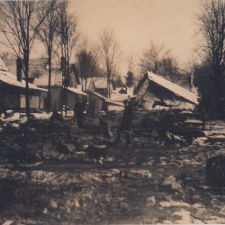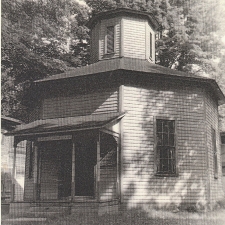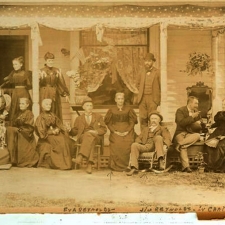



A History of Cassadaga Camp. Compiled by W. H. Bach, Lily Dale, N. Y., and Presented as a Premium to the Patrons of The Sunflower. Lily Dale, N. Y.: The Sunflower Print, July, 1899.
The Cassadaga Campmeeting is located at Lily Dale, N. Y., on the Dunkirk, Allegheny Valley & Pittsburg Railway, midway between Jamestown and Dunkirk, N. Y.
It consists of a tract of fifty-two acres, covered with a growth of fine shade trees, principally Maple, Beech, Birch and Hemlock. It is located on one of the four Cassadaga Lakes, three being connected by channels that are navigable.
The grounds are divided into blocks by nine streets running east and west and three running north and south, besides the foot paths through the parks.
There are three parks. Melrose, between the Auditorium and the entrance, Lincoln, extending from the Auditorium north, past the Grand Hotel and around the shore of the lake to the Bowling Alley and Electric Light works and Caldwell in which swings, croquet grounds, etc.; for the amusement of the younger generation can be found. These parks are filled with flower beds, nice grassy lawns, beautiful shade trees, settees and all that goes to make a delightful summer resort.
Of course, the feature of Cassadaga Camp is its Lecturers and Mediums. People come from all over the United States and Foreign Countries to spend from a few days to the entire season in order that they may learn the lessons that are taught from its platform.
No attempt will be made to give even a partial list of the names of individuals who have aided Cassadaga Camp to reach the position it now occupies. Neither will an attempt be made to give the credit for its successs to any set of individuals. Every visitor has added his or her mite towards its consummation.
In considering the receipts, it must be understood that they represent the receipts from all sources. Money taken in for all privileges, sale of stocks and bonds, money borrowed and donations. This money has been expended in beautifying the grounds, buildings, etc., in constructing roads and pathways, buildings, filling in low places, putting in a sewer, electric light and water works system, as well as to meet the expenses of the yearly convocations.
With heartfelt thanks to all who have aided to make this book possible and with the fervent wish that it may be the means of giving a better idea of one of the prominent gatherings of the Spiritualists, it is presented to the Patrons of THE SUNFLOWER, by
THE PUBLISHER.
A Spiritualist Society was formed at Laona in 1855 called The Religious Society of Free Thinkers. The Society purchased an old Universal Church to hold their meetings and many noted men and women appeared on platform in those early days. The eminent Scientist William Denton delivered lectures on geology and the Philosophy of Spiritualism. Later at various times lectures were: P.B. Randolph, George W. Taylor, Andrew Jackson Davis, Mary F. Davis, Elizabeth Lowe, Cora L.V. Scott, Henry C. Wright, Warren Chase, Selven J. Phinney, S.B. Brittan, John M. Spear and Lyman C. Howe.
Willard Alden a member of the Laona Spiritualists owned a farm along Middle Cassadaga Lake, about six miles from Laona. Mr. Alden used a section of his large house as a “stop over” for the travelers who used the Frisbe Road Stage Coach. Mr. Alden along with the Laona Spiritualists started a yearly “Spiritualist Picnic” on his farm grounds in 1873. Each year it lasted an extra day, hosted guest speakers and drew large crowds. In the spring of 1877 Jeremiah Carter of Laona heard an unseen voice clearly say to him “Go to The Alden’s and arrange for a camp meeting.” This unseen voice repeated it’s self again very clearly. The next morning Jeremiah Carter walked the entire six miles from Laona to Cassadaga. Did Jeremiah walk that long distance so he could clearly consider how he was going to present this spirit command to Willard Alden?
Willard Alden gladly accepted the plan of a Spiritualist Camp Meeting being held on his grove and grounds with the exception the expenses of paying for the lectures and provisions be met by the Spiritualists. A committee was formed and a Camp Meeting was held September 11 to September 16th, a total of six days. Mr. Carter collected a fee of ten cents from each visitor.
Willard Alden Passed to spirit life on February 25th 1878 and the 1878 Camp Meeting was held September 6th to the 16th with an added expense of $160 for the reason that Willard’s son Theodore had the Camp Grounds fenced in. A fee of ten cents was still collected from each visitor. At the business committee meeting on May 17, 1879 Theodore Alden asked that a percentage of the gate receipts be turned over to the Alden heirs as rent. The committee was unwilling to do this as they assumed the responsibility for the general expenses. Theodore Alden held to the percentage basis and the meeting was adjourned with a feeling of dissatisfaction and uncertainty as to the future.
1880
Spiritualist Camp Meetings
Emma Hardinge Britten, “Spiritual Camp Meetings,” Nineteenth Century Miracles; or, Spirits and Their Work in Every Country of the Earth. A Complete Historical Compendium of the Great Movement Known as “Modern Spiritualism.” New York: William Britten, 1884, pp. 542-550.
[Partial quote from–http://www.spirithistory.com/80camps.html]
To a visitor who has never before beheld, or taken part in such a scene, a Spiritualistic camp meeting produces an indescribable feeling of strangeness and bewilderment, which scarcely allows him to determine whether he is under the influence of pleasure or pain. The gatherings are so vast, the scenes so new, and each member of the busy crowd seems so intent on pursuing his own special avocation, that a sense of loneliness, even of desolation, such as if often experienced by strangers in thronged cities, almost invariably possesses the sensitive mind. Gradually, the multitude of objects crowding in upon view on every side, arrange themselves into order, and then the sight is one of endless interest and amusement. To a lounger passing through the various groups, some arranged in picturesque knots at the tent doors, others reclining beneath shady trees, or stretched out upon grassy knolls, the fragments of conversation that meet the ear are as curious and heterogeneous, as the objects that appeal to the sense of vision. From the first peep of day, the campers are astir, lighting gipsy fires, preparing breakfast, and trading with the various hawkers who ply with their provisions regularly through the white-tented streets. After the morning meal, visits are exchanged, and the business of the day proceeds with as much energy and order as in the cities. Sailing parties, séances, amusements, and business, all proceed in due course, until the hour for speaking arrives, when thousands assemble at the speaker’s stand, to partake of the solid intellectual refreshment of the day. Lectures, balls, parties, illuminations, public discussions, &c., &c., fill up the time until midnight, when the white tents enclose the slumbering hosts; the fires and lamps are extinguished, and the pale moonbeam shines over rocks, groves, and lakes, illumining scenes as strange and picturesque as ever the eye of mortal gazed upon. Resembling to some extent a martial camp, but adorned with flowers, wreaths, and emblems of taste and beauty, instead of the grim paraphernalia of war, the stern sentinel with musket in hand is exchanged for watching angels. Instead of the savage password, “Death and glory,” “Life eternal” is whispered in every breeze that stirs the tree tops, and the white tents, instead of sheltering the fever-racked forms of mailed victims, only waiting for the shrill cry of the bugle to marshal them to murder or death, shade the peaceful slumbers of those who know no death, and who are tenderly guarded by the glittering rank and file who have triumphed over the grave, and risen as immortal victors from life’s cruel battlefields.
Amongst those who greet you as you take your morning’s walk from street to avenue, or linger on rocky pinnacles to contemplate the busy hive of life thronging below, are strangers from States a thousand miles off, and neighbours from the next village. You may talk politics with a white-haired knot of grandsires sunning themselves on a social bench, around an ancient elm; talk metaphysics with a group of lecturers assembled “from the four corners of the earth,” hear some merry “Indian maid” pouring out through the lips of her entranced “medy,” shrewd philosophy.
History of Lily Dale
The History of Lily Dale Camp is one of courage, stamina and dedication. It all began in the year 1844 – preceding the Hydesville manifestations by the Fox sisters. In the small village of Laona, a few miles from Lily Dale, Dr. Moran (mesmerist from Vermont) was invited by William Johnson, to lecture before a group of interested people. Mr. Johnson the son of a minister was the father of Marion Skidmore who became a great leader for Spiritualism at Lily Dale. At that time Jeremiah carter, physically enfeebled, had sought to be treated by Dr. Moran. Unfortunately Dr. Moran had to leave before such could be applied. Mr. Johnson suggested that they themselves try the experiments, demonstrated by the Vermont doctor. The results were startling. Mr. Carter became entranced. An entity to be a Dr. Hedges spoke to the people present – giving messages from spirit and demonstrating the laying on of hands.
The advent of the Hydesville manifestations strengthened the purpose of the group and they termed themselves Spiritualist and Liberals. The group met regularly to discuss their beliefs and practice their healing and mediumship. Many great speakers and mediums had their early beginnings in Laona. In 1855 the First Spiritualist Society of Laona was formed.
In 1873 Willard Alden owned a good size farm (now known as the Leolyn Hotel and woods) just outside the gates of Lily Dale. Jeremiah Carter insisted that spirit voices kept continuously urging him to go to Alden’s farm and start a camp meeting. This was accomplished and the group met there for summer picnics and camp meetings. After Mr. Alden’s transition, his heirs became dissatisfied with financial arrangements, so the board in 1879 decided to purchase land and move their location. Twenty acres of land was purchased from John Fisher at the price of $1845. This is now known as the Lily Dale Assembly.
Mrs. Amelia Colby was asked to name the camp. Her guide gave her the name of Cassadaga Lake Free Association. In 1903 the name was changed to The City Of Light and in 1906, The Lily Dale Assembly: named for the abundance of lilies on the lake.
Men and women worked tirelessly side-by-side, felling trees, clearing brush and making winding paths through the forest. The first service was held at Lily Dale under a cradle of boughs known as The Bough House, fashioned from entwining branches and flowers. Rough-hewn logs were used for benches.
The first speaker at Lily Dale was Elizabeth Lowe Watson. She was a dynamic speaker, a liberal and suffragette.
Financial problems were experienced from the early beginning of the camp, this acted strangely enough, not as a deterrent, but as a challenge to go forward and work harder towards the anticipated goal. The first order of business of the camp was the discussion of building a permanent Auditorium. This was accomplished in 1883, and later remolded in 1901. The seating capacity was twelve hundred. There has been many times during Lily Dale’s history that people stood three deep outside the auditorium in order to hear the lecture.
Preceding the auditorium in 1881, a Lyceum was formed with the children meeting in a tent. They felt that training of the young was important. In 1928 the Andrew Jackson Davis building for the Lyceum was built and gifted to Lily Dale by Mrs. M. Cadwallader, the editor of “The Progressive Thinker.”
In 1895 the Alden House was purchased by Mrs. Abby Louise Pettengill and renamed The Leolyn after her granddaughter. The Assembly then purchased the Leolyn from Mrs. Pettengill.
A hotel was built in 1880. It originally was the horse barn. It is known as a “hung suspension building.” When additional floors were needed each floor was raised and the new additions placed underneath. It was known as the Grand Hotel – today it is the Maplewood Hotel.
Today the Maplewood Hotel stands serenely, her old time charm still intact, overlooking the lake enticing the occupants to relax on its wide porch, and watch the ducks and swans, glide by. Many philosophical subjects have been debated and aired on the Maplewood porch. Bit by bit these sturdy pioneers plodded forward – roads were built, sewers installed, lights became a reality. The first Library was held in a tent in the park in 1886. Today it stands proudly as the Marion Skidmore Library housing thousands of the finest books on Spiritualism.
The Assembly Hall, famous for it’s thought exchange and class work came into being in 1888, the old school building in 1890. The Octagon Building was reserved for class, arts and the teaching of proper dancing. It housed the Junior League for years then became the “mediums’ building. The beautiful Healing Temple was built by Louis Vosberg at the direction of T.J. Kelly’s guide. This National Missionary was one of the most outstanding mediums that has served the Lily Dale platform. Incidentally, the famous actress Mae West, a friend of Jack Kelly visited Lily Dale at his invitation.
The original fox Cottage was moved from Hydesville, New York, a gift from Benjamin Bartlett of Cambridge Springs, Pennsylvania and placed at Lily Dale in 1915. Tragically the cottage burned to the ground early morning in 1955. Fortunately the Peddler’s trunk and family Bible were saved.
In 1898 Lily Dale had it’s own newspaper, The Sunflower. The editor was William Bach, who with his wife Evielena erected the Sunflower Pagoda. The United States Government in 1888 established the Lily Dale Post Office ensuring the inhabitants not only the convenience of it’s service but recognizing Lily Dale on the map.
From its lowly beginning of twenty acres, Lily Dale now owns approximately one hundred sixty acres.
Lily Dale has a splendid volunteer fire department. These men and women give freely of their time and efforts to protect the camp.
Truly Lily Dale lived up to that early promise. Thirty thousand people come through the gates each year. Lily Dale has comforted the bereaved, demonstrated the truth of immortality, and shown others a way of life known as the Religion of Spiritualism.
All of the people who visited Lily Dale contributed to “Beautiful Lily Dale.”
It is a worn cliché that the first hundred years are the hardest. If that is so, then Lily Dale has truly weathered the storms and kept the faith, knowing that the guiding light has been, and forever will be “the Eternal Light of Spirit.”